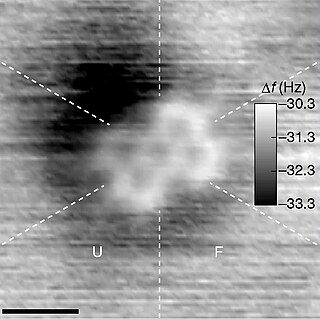Related Research Articles
A chemical formula is a way of presenting information about the chemical proportions of atoms that constitute a particular chemical compound or molecule, using chemical element symbols, numbers, and sometimes also other symbols, such as parentheses, dashes, brackets, commas and plus (+) and minus (−) signs. These are limited to a single typographic line of symbols, which may include subscripts and superscripts. A chemical formula is not a chemical name, and it contains no words. Although a chemical formula may imply certain simple chemical structures, it is not the same as a full chemical structural formula. Chemical formulae can fully specify the structure of only the simplest of molecules and chemical substances, and are generally more limited in power than chemical names and structural formulae.
In chemistry, the empirical formula of a chemical compound is the simplest whole number ratio of atoms present in a compound. A simple example of this concept is that the empirical formula of sulfur monoxide, or SO, would simply be SO, as is the empirical formula of disulfur dioxide, S2O2. Thus, sulfur monoxide and disulfur dioxide, both compounds of sulfur and oxygen, have the same empirical formula. However, their molecular formulas, which express the number of atoms in each molecule of a chemical compound, are not the same.

A molecule is a group of two or more atoms held together by attractive forces known as chemical bonds; depending on context, the term may or may not include ions which satisfy this criterion. In quantum physics, organic chemistry, and biochemistry, the distinction from ions is dropped and molecule is often used when referring to polyatomic ions.
Benzol may refer to:

In science, a formula is a concise way of expressing information symbolically, as in a mathematical formula or a chemical formula. The informal use of the term formula in science refers to the general construct of a relationship between given quantities.

Casomorphin is an opioid peptide derived from the digestion of the milk protein casein.
The International Chemical Identifier is a textual identifier for chemical substances, designed to provide a standard way to encode molecular information and to facilitate the search for such information in databases and on the web. Initially developed by the International Union of Pure and Applied Chemistry (IUPAC) and National Institute of Standards and Technology (NIST) from 2000 to 2005, the format and algorithms are non-proprietary. Since May 2009, it has been developed by the InChI Trust, a nonprofit UK charity which works to implement and promote the use of InChI.
Dichloroethane can refer to either of two isomeric organochlorides with the molecular formula C2H4Cl2:
The molecular formula C4H10O may refer to:
The molecular formula C4H4O4 (molar mass: 116.07 g/mol) may refer to:
Dioxin may refer to:
The molecular formula C2H4N2O2 may refer to:
The molecular formula C9H8O may refer to:
The molecular formula C4H7ClO may refer to:
The molecular formula C12H18BrNO2 (molar mass: 288.18 g/mol, exact mass: 287.0521 u) may refer to:
Octynes are alkynes with one triple bond and the molecular formula C8H14.
Nonynes are alkynes with one triple bond and the molecular formula C9H16.
Decynes are alkynes with one triple bond and the molecular formula C10H18.
Benzoin may refer to:
Heptynes are alkynes with one triple bond and the molecular formula C7H12.
References
- ↑ "38444-13-2(4-AMYLPHENYL 4'-METHOYXBENZOATE) Product Description". Chemical Book. Retrieved 7 October 2021.
- ↑ Sung-Eun Suh; Leah E. Nkulu; Shishi Lin; Shane W. Krska; Shannon S. Stahl (2021). "Benzylic C–H isocyanation/amine coupling sequence enabling high-throughput synthesis of pharmaceutically relevant ureas". Chemical Science. 12 (30): 10380–10387. doi: 10.1039/D1SC02049H .